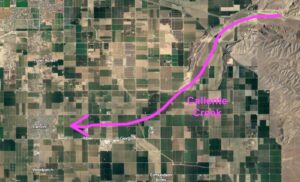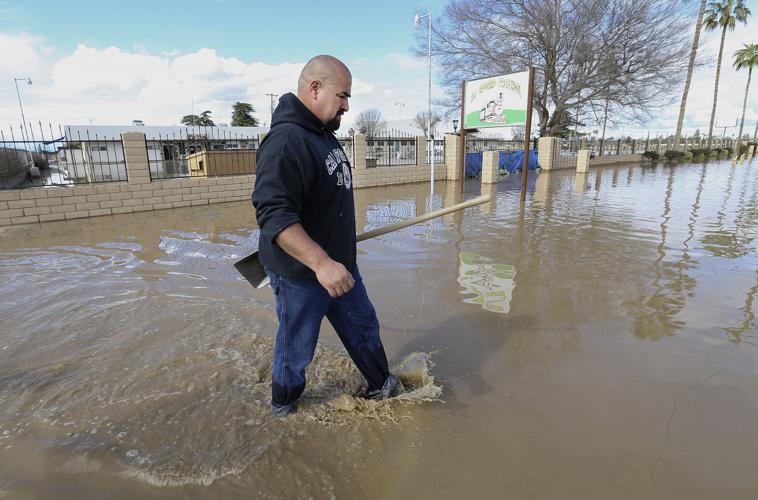Of all the places that unexpectedly flooded this past year, there was one that unexpectedly did not – Lamont.
Typically, heavy rain years kick up water in the Caliente Creek and it comes rushing east out of the Tehachapi Mountains, turns south under Highway 58 into a wide wash and floods out Lamont. Years ago, the water would have spread out like a sheet and continued south toward Arvin. But farmers built a levee along Mountain View Road and lined it with tamarisk trees. The structure is easily spotted on satellite map views of the area.

That levee has, for many, many years, funneled Caliente Creek’s water straight into the homes and businesses of unincorporated Lamont.
The last time it happened was 2017 putting streets under knee-high water.
This was a far bigger water year than 2017, but Lamont stayed mostly dry.
Why?
“I asked the same question,” said Kern County Supervisor David Couch, whose district includes Lamont.
He credited a number of factors, including the county’s recent purchase of some “buffer land” north of Highway 58 near the Bena Landfill that the county leveled out to carve a wider channel that slowed the Caliente’s flow, allowing much of the water to sink before it got near Lamont.
“Very little water went past 58,” Couch said.
For the water that made it past that buffer, most was corralled into a series of sumps just east of Lamont on Panama Road. The first three sumps are shallow, designed to let the silt in Caliente’s notoriously silty water sink. As the water clears, it moves from sump to sump until it gets to the fourth and largest sump, where much of it can percolate into the groundwater, said County Public Works Director Joshua Champlin.

If the creek is flooding so heavily that all those facilities fill up, he said, the county can open a fifth chamber in an attempt to slow the water before it travels west on Panama through the town.
While the system has worked well, it’s not main the reason Lamont didn’t flood this year. And it won’t be enough to protect the town in a really big flood, Champlin said.
“The reality is, Caliente is more prone to flooding from heavy rain cells,” Champlin said. “Very little snow pack came off the Caliente watershed this year, unlike on the Kern River and Poso Creek. That’s the real reason Lamont didn’t flood this year.”
And unlike Kern’s other creeks and rivers, no one really wants water from the Caliente. It has way too much silt. The fine grit clogs infrastructure and forms a near impermeable cap over good percolation ground. Which is why farms have worked to keep it off their land. Legal attempts to force farmers to remove levees have failed, Champlin said.
Champlin praised the county’s existing flood control system for Lamont but said it will not keep the town dry in a 100-year flood.
“That’s the event we’re trying to prepare for,” he said.
The county commissioned a feasibility study and conceptual plan in 2019 aimed at protecting against exactly that big flood. It would have created a similar, but much larger, water detention facility on about 500 acres to the north and south of Highway 58.
“It would have realigned the creek closer to its natural path to detain the water and slow it down,” Champlin explained.
But the property owners wanted twice what the property was appraised for and government rules prohibit paying over market value, Champlin said.
So, the county went hunting for other land and found about 140 acres on Comanche Road that it’s negotiating for now.
The county has set aside funds from American Rescue Plan Act, passed during the COVID-19 crisis, for the project. Champlin hopes they will have enough to buy the property and start some improvements.
But the clock is ticking. Champlin said there are strict timelines to spend those federal dollars.
And, by all accounts, we are heading into an El Niño winter, which could mean another big water year.
Share this:
- Click to share on Facebook (Opens in new window)
- Click to share on Twitter (Opens in new window)
- Click to share on LinkedIn (Opens in new window)
- Click to share on Reddit (Opens in new window)
- Click to share on Tumblr (Opens in new window)
- Click to share on Pinterest (Opens in new window)
- Click to share on Pocket (Opens in new window)
- Click to share on Telegram (Opens in new window)
- Click to share on WhatsApp (Opens in new window)
- Click to print (Opens in new window)








You must be logged in to post a comment.